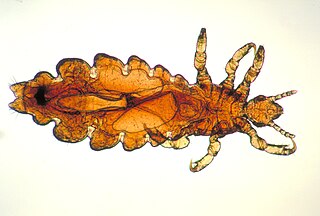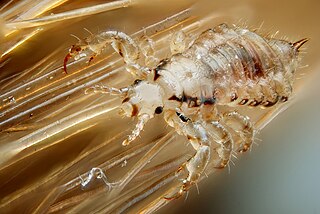
Epidemic typhus, also known as louse-borne typhus, is a form of typhus so named because the disease often causes epidemics following wars and natural disasters where civil life is disrupted. Epidemic typhus is spread to people through contact with infected body lice, in contrast to endemic typhus which is usually transmitted by fleas.

Sucking lice have around 500 species and represent the smaller of the two traditional superfamilies of lice. As opposed to the paraphyletic chewing lice, which are now divided among three suborders, the sucking lice are monophyletic.

Pediculosis is an infestation of lice from the sub-order Anoplura, family Pediculidae. Accordingly, the infestation with head lice is named pediculosis capitis, while this with body lice, pediculosis corporis. Although pediculosis in humans may properly refer to lice infestation of any part of the body, the term is sometimes used loosely to refer to pediculosis capitis, the infestation of the human head with the specific head louse.

The head louse is an obligate ectoparasite of humans. Head lice are wingless insects that spend their entire lives on the human scalp and feed exclusively on human blood. Humans are the only known hosts of this specific parasite, while chimpanzees and bonobos host a closely related species, Pediculus schaeffi. Other species of lice infest most orders of mammals and all orders of birds.

Bartonella henselae, formerly Rochalimæa henselae, is a bacterium that is the causative agent of cat-scratch disease (bartonellosis).
Tick-borne diseases, which afflict humans and other animals, are caused by infectious agents transmitted by tick bites. They are caused by infection with a variety of pathogens, including rickettsia and other types of bacteria, viruses, and protozoa. The economic impact of tick-borne diseases is considered to be substantial in humans, and tick-borne diseases are estimated to affect ~80 % of cattle worldwide. Most of these pathogens require passage through vertebrate hosts as part of their life cycle. Tick-borne infections in humans, farm animals, and companion animals are primarily associated with wildlife animal reservoirs. many tick-borne infections in humans involve a complex cycle between wildlife animal reservoirs and tick vectors. The survival and transmission of these tick-borne viruses are closely linked to their interactions with tick vectors and host cells. These viruses are classified into different families, including Asfarviridae, Reoviridae, Rhabdoviridae, Orthomyxoviridae, Bunyaviridae, and Flaviviridae.

Bartonella is a genus of Gram-negative bacteria. It is the only genus in the family Bartonellaceae. Facultative intracellular parasites, Bartonella species can infect healthy people, but are considered especially important as opportunistic pathogens. Bartonella species are transmitted by vectors such as ticks, fleas, sand flies, and mosquitoes. At least eight Bartonella species or subspecies are known to infect humans.

Carrion's disease is an infectious disease produced by Bartonella bacilliformis infection.

The treatment of human lice is the removal of head lice parasites from human hair. It has been debated and studied for centuries. However, the number of cases of human louse infestations has increased worldwide since the mid-1960s, reaching hundreds of millions annually. There is no product or method that assures 100% destruction of the eggs and hatched lice after a single treatment. However, there are a number of treatment modalities that can be employed with varying degrees of success. These methods include chemical treatments, natural products, combs, shaving, hot air, and silicone-based lotions.
Bartonellosis is an infectious disease produced by bacteria of the genus Bartonella. Bartonella species cause diseases such as Carrión's disease, trench fever, cat-scratch disease, bacillary angiomatosis, peliosis hepatis, chronic bacteremia, endocarditis, chronic lymphadenopathy, and neurological disorders.
Relapsing fever is a vector-borne disease caused by infection with certain bacteria in the genus Borrelia, which is transmitted through the bites of lice or soft-bodied ticks.

The body louse is a hematophagic ectoparasite louse that infests humans. It is one of three lice which infest humans, the other two being the head louse, and the crab louse or pubic louse.

Bacillary angiomatosis (BA) is a form of angiomatosis associated with bacteria of the genus Bartonella.
Bartonella rochalimae is a recently discovered strain of Gram-negative bacteria in the genus Bartonella, isolated by researchers at the University of California, San Francisco (UCSF), Massachusetts General Hospital, and the United States Centers for Disease Control and Prevention. The bacterium is a close relative of Bartonella quintana, the microbe which caused trench fever in thousands of soldiers during World War I. Named after Brazilian scientist Henrique da Rocha Lima, B. rochalimae is also closely related to Bartonella henselae, a bacterium identified in the mid-1990s during the AIDS epidemic in San Francisco as the cause of cat scratch fever, which still infects more than 24,000 people in the United States each year.
Bartonella quintana, originally known as Rochalimaea quintana, and "Rickettsia quintana", is a bacterium transmitted by the human body louse that causes trench fever. This bacterial species caused outbreaks of trench fever affecting 1 million soldiers in Europe during World War I.
Ehrlichia chaffeensis is an obligate intracellular, Gram-negative species of Rickettsiales bacteria. It is a zoonotic pathogen transmitted to humans by the lone star tick. It is the causative agent of human monocytic ehrlichiosis.

Head lice infestation, also known as pediculosis capitis, is the infection of the head hair and scalp by the head louse. Itching from lice bites is common. During a person's first infection, the itch may not develop for up to six weeks. If a person is infected again, symptoms may begin much more quickly. The itch may cause problems with sleeping. Generally, however, it is not a serious condition. While head lice appear to spread some other diseases in Africa, they do not appear to do so in Europe or North America.

Pediculosis corporis or Vagabond's disease is a cutaneous condition caused by body lice that lay their eggs in the seams of clothing.

African tick bite fever (ATBF) is a bacterial infection spread by the bite of a tick. Symptoms may include fever, headache, muscle pain, and a rash. At the site of the bite there is typically a red skin sore with a dark center. The onset of symptoms usually occurs 4–10 days after the bite. Complications are rare but may include joint inflammation. Some people do not develop symptoms.

Cat-scratch disease (CSD) or felinosis is an infectious disease that most often results from a scratch or bite of a cat. Symptoms typically include a non-painful bump or blister at the site of injury and painful and swollen lymph nodes. People may feel tired, have a headache, or a fever. Symptoms typically begin within 3–14 days following infection.











